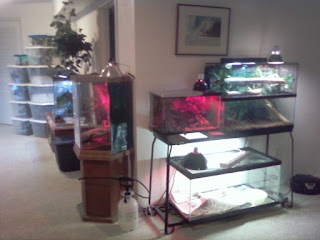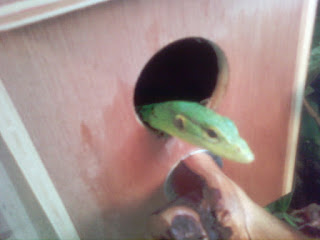These are a list of herps I have had experience with either as pets, cared for, or observed and then caught in the wild.
Cuban Knight Anole (Anolis equestris)
Green Anole (Anolis carolinensis)
Brown Anole (Anolis sagrei)
Bark Anole (Anolis distichus)
Crested Gecko (Rhacodactylus ciliatus)
Tokay Gecko (Gekko Gecko)
White Lined Gecko (Gekko Vitattus)
House Gecko (Hemidactylus frenatus)
Marbled Gecko (Christinus mamoratus)
Golden Gecko (Gekko ulikovskii)
White Spotted Gecko (Tarentola annularis)
Crocodile Gecko (Tarentola mauritanica)
Giant Day Gecko (Phelsuma madagascariensis grandis)
Lined Day Gecko (Phelsuma lineata)
Green Iguana (Iguana iguana)
Irian Jaya Blue Tongue Skink (scientifically undescribed(Tiliqua sp)
Schneider's Skink (Eumeces schneideri)
Five Lined Skink(Eumeces fasciatus)
Ground Skink (Scincella lateralis)
Broad-headed Skink (Eumeces laticeps)
Eastern Glass Lizard (Ophisaurus ventralis)
Short Horned Lizard (Phrynosoma hernandesi)
Eastern Fence Lizard (Sceloporus undulatus)
Bearded Dragon (Pogona Vitticeps)
Veiled Chameleon (Chamaeleo calyptratus)
Oustalet's Chameleon (Furcifer oustaleti)
Emerald Tree Monitor (Varanus prasinus)
Dumeril's Monitor (Varanus dumerilii)
Savannah Monitor (Varanus exanthematicus)
Nile Monitor (Varanus niloticus)
Yellow Bellied slider (Trachemys scripta scripta)
Red Eared slider (Trachemys scripta elegans)
Midland Painted Turtle (Chrysemys picta)
Common Map Turtle (Graptemys geographica)
Common Snapping Turtle (Chelydra serpentina)
Common Musk Turtle (Sternotherus oderatus)
Narrow-bridged Musk Turtle (Claudius angustatus)
Eastern Box Turtle (Terrapene carolina)
Wood Turtle (Glyptemys insculpta)
Eastern American Toad (Bufo americanus)
Giant Bufo Toad (Bufo marinus)
Green Tree Frog (Hyla cinerea)
Gray Tree frog (Hyla versicolor)
American Bull Frog (Rana catesbeiana)
Green Frog (Rana clamitans)
African Clawed Frog (Xenopus laevis)
African Dwarf Frog (Hymenochirus boettgeri)
Argentine Horned Frog (Ceratophrys ornata)
Leopard Frog (Rana pipiens)
Spring Peeper Frog (Pseudacris crucifer)
Wood Frog (Rana sylvatica)
Chinese Fire Belly Newt (Cynops orientalis)
Ridge Back Newt (Paramesotriton hongkongensis)
Redback Salamander (Plethodon cinereus)
Longtail Salamander (Eurycea longicauda longicauda)
Northern Two-Lined Salamander (Eurycea bislineata bislineata)
Mountain Dusky Salamander (Desmognathus ochrophaeus)
Northern Dusky Salamander (Desmognathus fuscus fuscus)
Axolotol (Ambystoma mexicanum)
Brahminy Blind Snake (Ramphotyphlops braminus)
Garter Snake (Thamnophis sirtalis)
Western Terrestrial Garter Snake (Thamnophis elegans)
Corn Snake (Elaphe guttata)
Black Rat Snake (Elaphe obsoleta)
Leucistic Texas Rat Snake (Elaphe obsoleta lindheimeri)
California King Snake (Lampropeltis getula californiae)
Yellow Rat Snake (Elaphe obsoleta quadrivittata)
Cottonmouth Snake (Agkistrodon piscivorus)
Copperhead Snake (Agkistrodon contortrix)
Ring neck snake (Diadophis punctatus)
Black Racer Snake (Coluber constrictor priapus)
Northern Water Snake (Nerodia sipedon)
Ball Python (Python regius)
Burmese Python (Python molurus bivittatus)
American Alligator (Alligator mississippiensis)
This is all I can think of at the moment but I'm sure I'll have to put more up here as I remember them. The venomous snakes on here are the only animals on this list I caught and released the same day. Everything else I've kept as pets, cared for or at least observed in captivity for a week or more. Most on the list have been or are currently my pets:)

















































